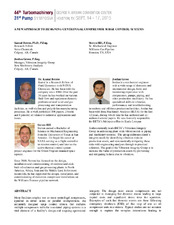| dc.description.abstract | Many facilities employ two or more centrifugal compressors, operated in either series or parallel configurations. An accurately designed surge control system that includes multiple compressors with the associated piping systems is a vital element of a facility’s design and ongoing operational integrity. The design must ensure compressors are not subjected to damaging fast dynamic events leading to large capital costs and significant down time for operators. Examples of such fast dynamic events are those following emergency shutdown (ESD) of fast stop of one or all compressor units in a station. Typical studies are not accurate enough to capture the complex interactions leading to catastrophic events, especially for complicated system arrangements. This paper introduces three methods of surge control analysis that can be conducted to assess the effectiveness of any surge control system design to prevent the compressor from surge. The first method utilizes the perturbation theory to relate the compressor deceleration and the resulting drop in its flow and head to determine the elapsed time that the compressor can stay out of surge before the surge control system brings about enough positive flow to prevent the unit from undergoing deep surge. The second method is simpler, and is based on a dimensionless number, called the inertia number, which combines the salient parameters from the dynamic equation between the fluid energy and that of the compressor rotor inertia to determine, as a first cut check, if the surge control system is adequate. The third method, which is always recommended, and is based on solving the full gas dynamic partial differential equations (PDEs) in spatial and temporal domain, which describe the true dynamic characteristics of the flow through the various piping elements, the compressor itself, to provide much more accurate predictions of surge control system behavior during fast transient events. Comparisons are made to field measurements to provide model validations, and an example application (Case Study) of three units operating in parallel. The first two (Units 6 and 7) were existing in a compressor station, while the third (Unit 8) was an add-on. The addition of Unit 8 meant a number of station layout modifications, which included: re-wheeling of Units 6 and 7 (i.e., change the compressor impellers); adding after gas cooling; and relocating the anti-surge valves downstream of the coolers to allow for both hot (fast stop) and cold recycle (anti-surge) capabilities. Due to the addition of equipment and significant reconfiguration of station piping and valves, a dynamic surge analysis on Units 6, 7, and 8 was required to determine whether the existing anti-surge and fast stop valves were adequately sized and whether the anti-surge valves could be relocated downstream of the gas coolers. A new fast stop recycle system was added along with Unit 8, which also needed to be adequately sized. Further complications arose from the fact that Unit 6’s anti-surge valve configuration differs from that of Unit 7 and that Unit 6 has twin recycle valves jointly serving as anti-surge valves with a single fast stop valve while Unit 7 has a single antisurge valve and a single fast stop valve. | en |


